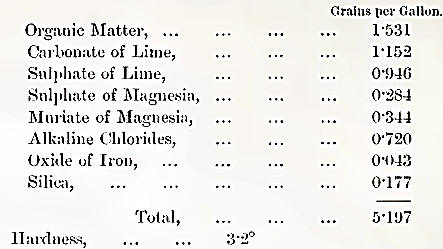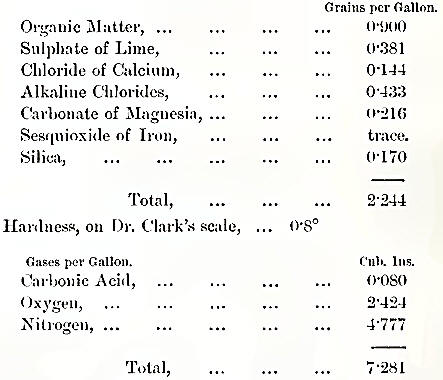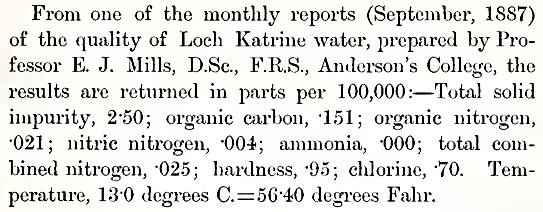|
Up to the year 18G0 the greater part, or north side,
of Glasgow was supplied from the river. The water was taken in from
the stream above a bend in the river beyond the Dalmarnock Bridge,
and after being filtered was pumped up to reservoirs in different
parts of the city, such as at Drygate, Itottenrow, Garnethill, and
Cran-stonhill. There were altogether three pumping stations and
thirteen pumping engines, placed as follows:—Seven at Dalmarnock,
four at Cranstonhill, and two at Drygate. Two of the engines at
Dalmarnock wore very powerful, and went by the names of “Samson and
Goliath.” They were on the Cornish principle, with cylinders of 72
inches diameter and 10 feet stroke. Samson could elevate 3,000,000
gallons a day, and Goliath 5,500,000 gallons; the latter, however,
supplying till Dow-level districts, did not work against such a back
pressure as Samson. These old works have the special interest that
the filtered water was originally carried across the river to the
pumping engines by means of a 15-inch spherical-jointed pipe,
designed by James Watt.
The Gorbals Water Works were started in 1845. The
water is drawn from the drainage area lying on the hill slopes to
the south of Glasgow, and stored in artificial reservoirs, situated
about six miles from Glasgow and at varying heights above the city,
generally about 300 feet above ordnance datum. The average rainfall
Is about 45 inches, and the quality of the water flowing off the
trap-rocks which compose the hills is pure, the analysis giving:—

The water is filtered and supplied to the city in
cast-iron pipes 24 inches diameter.
Like the Improvements 011 the river, the water supply
of the city has had the benefit of much wide and varied experience.
In the old days the public wells were the sources from which the
inhabitants drew their supplies. The earliest attempt to organize a
supply—limited, indeed, but still effective so far as it went in the
then small area—was that by a Mr. Harley, whose baths and byres are
still spoken of by old residenters. Mr. Harley started a supply
station about the head of West High Street, and sent the Avater
which had been pumped into a reservoir out through the town for
sale.
In 1806 a company was formed, called the Clasgow
Water Works Company, avIio brought in a supply from a point on the
Liver a few miles above the city. In 1808 another company was
started, called the Cranstonhill Water Works Company, who secured
ground at Cranstonhill, where they made reservoirs, the water for
which was pumped from the Clyde in the neighbourhood. Later on they
removed the pumping station further up the river.
After about thirty years of competition the two
companies were amalgamated. In 1855 the works of the Glasgow and
Gorbals Water Companies were taken over by the Town Council, and the
Loch Katrine Water Works opened in 1860.
For a long time previous to that date the Town
Council had been moving for a better supply to the city, they having
instituted a series of surveys of the available resources around
Glasgow. Various reports were handed in by the skilled engineers
employed, the districts considered lying more or less around the
city. Thus in 1834 the Earn Water, to the south of the city, was
proposed. Ill 1836 the North Calder and the Avon, several miles up
the valley of the Clyde, and two of its tributaries, were brought
forward. The engineer of this scheme was Mr. Robert Thom, who
introduced waterpower at Rothesay for factory purposes, and carried
out the Shaws Water Works, for the supply of Greenock.
In 1837 another scheme was proposed, the water in
this case to be drawn from the district lying south of Paisley.
Later on a scheme to pump water from Loch Lomond appeared; another
had the River Endrick as a source of supply, while in 1844 a
proposal came forward to utilize the Clyde itself, but above the
Falls.
These schemes coming to nothing, a company was formed
in 1845, who constructed the Gorbals works for the supply of the
part of the city lying on the south side of the river. In the same
year we find a company started, of which Mr. Lewis Gordon, the first
professor of civil engineering in Glasgow University, and Mr.
Laurence Hill, were the engineers. This scheme was the first bold
public proposal to tap the Highland lochs lying far to the north of
the city, the loch selected—Loch Katrine— being the one from which
the city now draws its pure and plentiful supply. This proposal had
influential support, and was only withdrawn on the Glasgow Water
Company arranging to bring in a supply from Loch Lubnaig, a larire
loch near Loch Katrine. It was afterwards found that the Loch
Lubnaig scheme was unworkable, and nothing was done.
Besides some of the names mentioned as engaged in the
various proposals brought forward, we find that of Professor Rankine,
the amiable and learned successor of Professor Gordon in the civil
engineering chair of the Glasgow University. Dr. Rankine, along with
Mr. John Thomson, in 1852, again brought forward the Loch Katrine
supply scheme. After about two years of further proposals the Town
Council managed to get the Loch Katrine scheme passed by Parliament,
the Glasgow and Gorbals works having passed into their hands.
Loch Katrine, celebrated by the genius of Sir Walter
Scott, is a loch of about seven miles in length, lying among the
schistose hills of the southern part of the Perthshire Highlands.
Its elevation above sea-level is about 300 feet. The water is very
pure and abundant, as the rainfall of the district is high, being
nearly 100 inches per annum. The level of the loch was raised 1 feet
by a masonry wall at the outlet where the river Teith emerges. A
tunnel, 11 mile long and 8 feet in diameter, was driven through the
outlying spurs of Beil Venue, after which the aqueduct runs through
a rough and out-of-the-way district, passing not far to the west of
Loch
Ard, famous as the scene of Bailie Nicol Jarvie’s
adventure and encounter with the Highlandmen at Aberfoyle, the
coulter of the plough which he is said to have used so successfully
in its red-hot state being still on view to the eyes of the curious,
hanging from a tree opposite the inn.
The contractors had a hard time of it; dynamite was
not then in the market, and gunpowder was the strongest ally they
could employ against the old metamorphic rocks.
Bridges, cast-iron troughs, cuttings in rock and
earth, piping, &c., were required to carry on the line until the
Endrick valley was reached, when a four-foot syphon pipe, 2½ miles
long, was laid. Another large tunnel, about 1½ mile in length, had
to be driven through the hifl ground to the north of Milngavie,
after which the aqueduct terminates at the Mugdock Reservoir—in all,
a distance of about 26 miles.
The Mugdock Reservoir is situated 317 feet above
sea-level, and contains 548,000,000 gallons. The water leaves the
reservoir by two main pipes, each 42 inches diameter, and which were
calculated to deliver the total daily supply for which the works
were constructed, viz. 50,000,000 gallons; thereafter two 36-inch
pipes continued the line to the city, about seven miles distant.
The total cost of the works was £9IS,000. They were
begun in 1856 and finished in 1859, being opened by Her Majesty the
Queen in person on the 14th October, 1859. The engineer was Mr. J.
F. Bateman, of London.
Additions were afterwards made by laying extra
piping, so that the whole estimated supply might be made available;
and now, the city has grown so rapidly that at the present time
additional works are in progress, designed by the Corporation Water
Works engineer, Mr. J. M. Gale, whereby the originally contemplated
fifty million gallons per day—which is now nearly all required to
meet present demands—may be about doubled, so as to meet the wants
of many years to come. These works necessitate other tunnels being
driven and additional piping laid, and another service reservoir at
Mugdock.
An analysis of the Loch Katrine water, made by the
late Dr. Penny in 1854, gives as follows:—

 |

